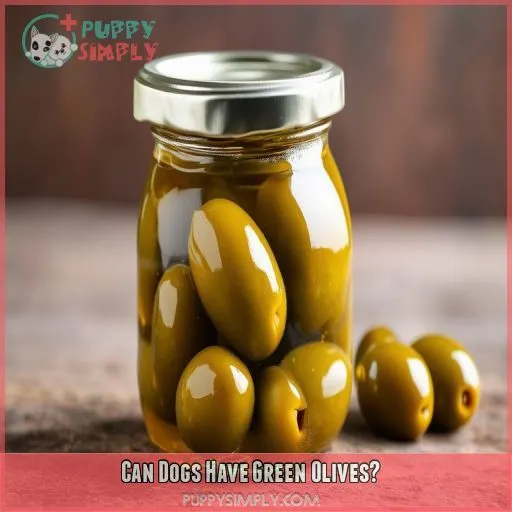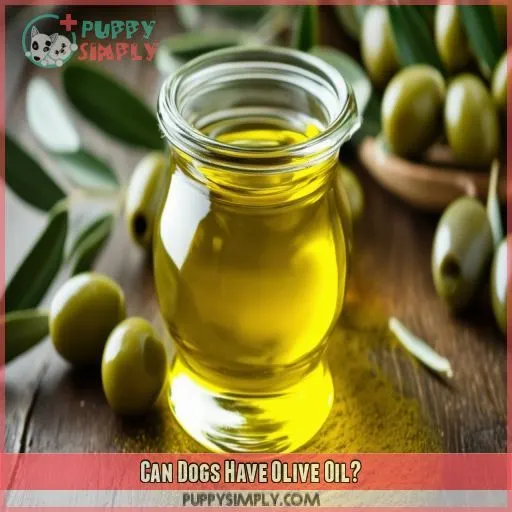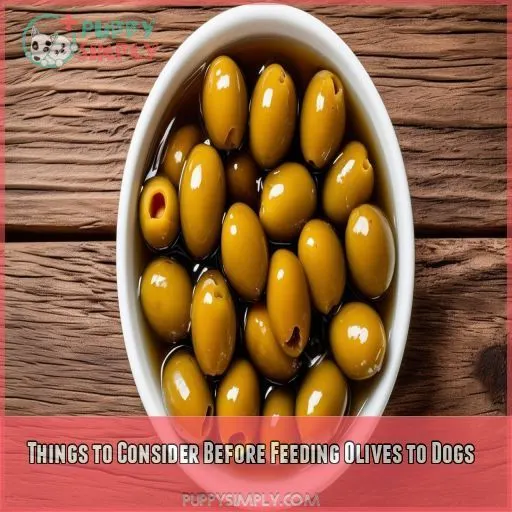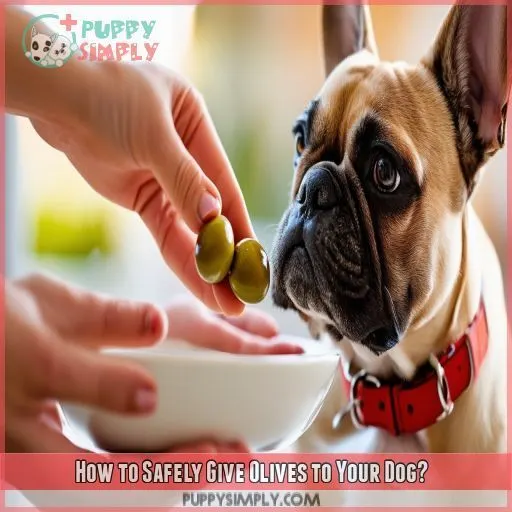This site is supported by our readers. We may earn a commission, at no cost to you, if you purchase through links.
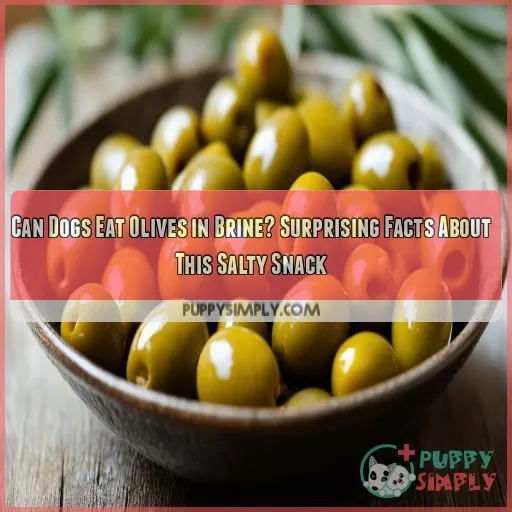
Though not toxic to dogs, olives have quite a high sodium content. So, the bottom line here is one of moderation.
If you’re going to share those olives with your furry friend, it would be vital that you know how and when to do so. It will help you make a correct decision as to whether olives in brine need to be on the menu of your dog or not
Table Of Contents
- Key Takeaways
- Can Dogs Eat Olives in Brine?
- Are Olives Safe for Dogs?
- Can Dogs Have Black Olives?
- Can Dogs Have Green Olives?
- Can Dogs Have Olive Oil?
- Things to Consider Before Feeding Olives to Dogs
- How to Safely Give Olives to Your Dog?
- Frequently Asked Questions (FAQs)
- Can dogs eat jarred olives?
- Can dogs eat olives with pimento?
- Are olives in brine still healthy?
- Are jarred olives in brine?
- Can dogs eat olives?
- Are canned olives healthy?
- Can dogs eat olives soaked in alcohol?
- Can dogs eat olives from martinis?
- How many olives in brine can a dog safely eat?
- Can brine-cured olives cause stomach upset in dogs?
- Are there any health benefits of brine olives for dogs?
- How long can dogs digest olives preserved in brine?
- Can brine from olives be used in dog food recipes?
- Conclusion
Key Takeaways
- Keep a lid on your dog’s olive consumption, even those in brine, to prevent a salty surprise.
- Opt for plain, pitted olives to avoid any choking hazards or unnecessary additives.
- Remember, olives are like a tasty treat – enjoy them sparingly to keep your furry friend’s health on track.
- If you’re unsure whether your canine companion can handle olives, don’t hesitate to consult your trusty vet for personalized advice
Can Dogs Eat Olives in Brine?
You might be wondering if your furry friend can enjoy olives in brine. While dogs can technically eat olives, brine-soaked ones aren’t the best choice.
Olive brine toxicity is a concern due to its high sodium content. Excessive sodium intake can lead to dog dehydration and other health issues.
Instead of olives in brine, consider offering your pup plain, pitted olives or explore healthier salty snacks. If you’re set on sharing olives, rinse them thoroughly to remove excess salt
Are Olives Safe for Dogs?
Olives are generally safe for dogs, but they’re not without risks. Your furry friend can enjoy them in moderation, provided you take some precautions. Here’s what you need to know:
- Remove pits to prevent choking hazards
- Opt for plain olives, avoiding those with pimentos or seasonings
- Steer clear of high-sodium varieties that can harm your dog’s health
- Choose fresh olives over those packed in brine
- Monitor your dog for any adverse reactions
While not toxic, olives aren’t a nutritional necessity for dogs. Their high sodium content can be problematic, especially for pups with certain health conditions. Always prioritize your dog’s safety and consult your vet before introducing new foods
Can Dogs Have Black Olives?
Black olives can be a safe treat for your furry friend. They’re less bitter than their green counterparts and pack a punch of healthy fats and antioxidants. However, moderation is key.
Always opt for pitted olives to prevent choking hazards. Black olives offer nutritional value, including vitamins A and E, but they’re still high in sodium.
While they can provide some health benefits, they shouldn’t replace your dog’s regular diet. Remember to introduce them gradually and monitor for any adverse reactions.
If you’re unsure, consult your vet before adding black olives to your pup’s menu
Can Dogs Have Green Olives?
While black olives are a safer option, you might wonder about green olives for your canine companion. Like their darker counterparts, green olives can be given to dogs in moderation. They offer similar heart-healthy fats and antioxidants, but they’re often higher in sodium.
When choosing green olives, opt for plain, unstuffed varieties without brine or seasonings. Remember, the nutritional value for dogs is minimal, so they shouldn’t replace healthier treats.
Always remove pits to prevent choking hazards. If you’re considering green olives, start with small amounts and monitor your dog’s reaction closely
Can Dogs Have Olive Oil?
While green olives can be safe for dogs, olive oil offers even more benefits. You can safely give your furry friend small amounts of high-quality extra-virgin olive oil. It’s packed with healthy monounsaturated fats and antioxidants, promoting a shiny coat and overall health.
However, moderation is key. Too much can lead to weight gain or digestive issues. Start with a teaspoon and monitor your dog’s reaction.
Avoid flavored oils with garlic or chili, as they’re unsafe for pups. Store olive oil properly to maintain its benefits.
Always consult your vet before introducing new foods to your dog’s diet
Things to Consider Before Feeding Olives to Dogs
Before giving olives to your canine friend, several critical factors have to be accounted for to keep them safe. These include service in limited amounts that wouldn’t choke, monitoring for allergies and sensitivities, monitoring the amount of added sodium, and using good quality olives without harmful additives or seasonings.
Moderation is Key
Though olive oil comes with some benefits, it’s necessary to consume olives in moderation.
Consider the size of your dog, its health condition, and nutritional needs to provide the proper serving size.
Even if olives aren’t recommended to be given in large portions as part of their meals, your dog is allowed to have them occasionally as a treat
They Must Be Pitted
While moderation is essential, ensure that you feed your dog pitted olives. Olive pits can present a choking hazard and even cause digestion problems. Thus, stick to pitted varieties to keep your furry friend safe and satisfied.
Allergies and Sensitivities
While pits are a concern, allergies and sensitivities can also pose risks. Watch for these reactions when introducing olives:
- Skin irritation or itching
- Digestive upset
- Breathing difficulties
- Unusual lethargy
Always start with small amounts and monitor closely
Sodium Content
While monitoring for allergies, don’t forget about sodium. Olives in brine can be high in salt, potentially affecting your dog’s health. Let’s break down the sodium content:
| Type of Olive | Sodium (mg/100g) | Impact on Dogs |
|---|---|---|
| Fresh | 1-2 | Minimal |
| Canned | 400-1000 | High |
| Brine-cured | 1000-2000 | Very High |
| Oil-cured | 50-100 | Moderate |
Quality of Olives
When considering olives for your dog, opt for organic, fresh varieties without preservatives or seasonings. These offer potential health benefits while minimizing risks. Avoid canned olives, as they’re often high in sodium. Quality matters for your pup’s safety and wellbeing
How to Safely Give Olives to Your Dog?
Be careful regarding the quantity and variety of olives you feed your dog. You can feed one or two olives only on a sporadic basis. The safe ones are plain, pitted, without flavorings or brine additions.
How Much is Safe to Give Your Dog?
Where portion control is concerned, less is more with olives for your dog. Think of them only as an infrequent treat or as a training reward—not as part of their regular diet. Since a single olive can be potent, start small and pay attention to the reaction in your pup. For larger dogs, this is generally just fine—1-2 olives on occasion. Small breeds should have half an olive or less.
- Slice olives into smaller pieces for easier digestion
• Olives as high-value reward during trainings
- Rotate olives with other healthy treats for variety
What Kinds of Olives Can Dogs Eat?
Not all olive varieties are created equal for your furry friend. Here’s a quick guide on how to help your pooch navigate the world of canine-friendly olives:
| Type of Olive | Safe for Dogs? | Considerations |
|---|---|---|
| Plain Black | Yes | Low sodium, antioxidants |
| Plain Green | Yes | More sodium-watch your intake |
Frequently Asked Questions (FAQs)
Can dogs eat jarred olives?
You shouldn’t give your dog jarred olives. They’re often packed in brine, which is high in sodium. If you must, choose plain, pitted olives without added ingredients. Always introduce new foods gradually and monitor for adverse reactions
Can dogs eat olives with pimento?
Like a wolf in sheep’s clothing, pimento-stuffed olives can be deceptive for your dog. You shouldn’t feed them to your canine companion. The pimentos may contain harmful ingredients, and the olives’ high sodium content isn’t ideal for dogs
Are olives in brine still healthy?
Olives in brine aren’t healthy for your dog. The high sodium content can lead to dehydration and other health issues. It’s best to stick with plain, pitted olives as an occasional treat. Always prioritize your pup’s well-being!
Are jarred olives in brine?
Yes, jarred olives are typically packed in brine. This saltwater solution preserves the olives, extending their shelf life. You’ll find most store-bought olives submerged in brine, which also enhances their flavor and texture. Always check the label for specific ingredients
Can dogs eat olives?
Dogs can eat olives if they’re plain, pitted, and given in moderation. Avoid olives with added ingredients or high sodium. Monitor your dog for any adverse reactions and consult your vet for personalized advice
Are canned olives healthy?
Canned olives aren’t healthy for dogs. They’re packed with brine, making them sodium bombs that can harm your pup’s heart and kidneys. Stick with plain, pitted olives in moderation to keep your furry friend safe
Can dogs eat olives soaked in alcohol?
Dogs shouldn’t eat olives soaked in alcohol, as alcohol is highly toxic to them. Even small amounts can lead to serious health issues, including central nervous system damage, vomiting, and even potentially fatal consequences
Can dogs eat olives from martinis?
Dogs shouldn’t eat olives from martinis. The alcohol and brine used in martinis are harmful and can cause serious health issues like alcohol poisoning, high sodium intake, and digestive problems. Stick to plain, pitted olives only
How many olives in brine can a dog safely eat?
It’s best to avoid giving your dog olives in brine because the high sodium content can be harmful. If you must, limit it to one or two olives and monitor for any adverse reactions
Can brine-cured olives cause stomach upset in dogs?
Brine-cured olives can cause stomach upset in dogs because they’re high in sodium, potentially leading to dehydration and gastrointestinal issues. Too much salt can be like a tidal wave, overwhelming your dog’s system
Are there any health benefits of brine olives for dogs?
Brine-cured olives don’t provide health benefits for dogs. Their high sodium content can lead to dehydration, increased blood pressure, or kidney issues. Stick to plain, pitted olives in moderation for a safer option
How long can dogs digest olives preserved in brine?
Dogs take about 8-10 hours to digest food, including olives preserved in brine. However, brined olives aren’t recommended due to high sodium content, which can cause health issues like dehydration, especially in sensitive dogs
Can brine from olives be used in dog food recipes?
You shouldn’t use brine from olives in dog food recipes. The high sodium content in brine can lead to dehydration and health issues, especially for dogs with kidney or heart problems. Use plain, fresh ingredients instead
Conclusion
Brine-soaked snacks, like olives, require careful consideration for dogs. Dogs can eat olives in brine, but only in small amounts due to their high sodium content. Make sure the olives do not contain a stone, and be aware of any allergies or sensitivities your dog may have. Opt for good-quality olives to reduce health risks. Olives can serve as a safe occasional treat. Always consult your vet before introducing new foods into your dog’s diet



